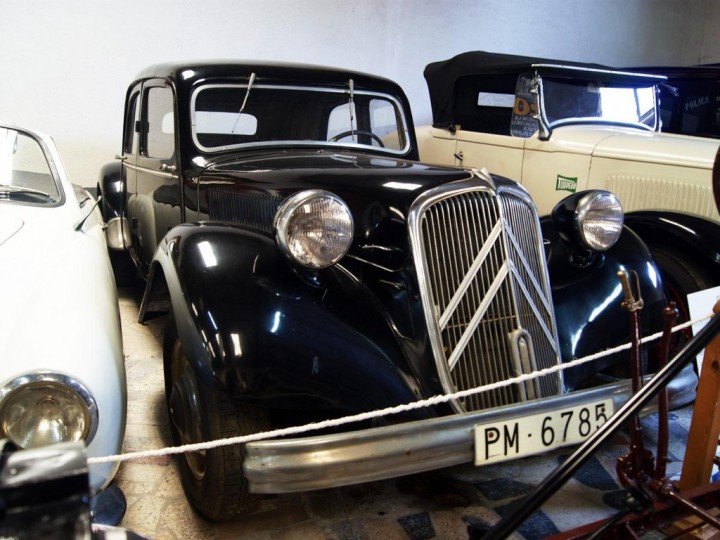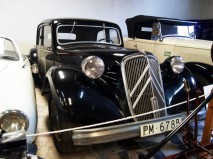1947 Citroen 15CV Traction Avant
The Traction Avant's structure was a welded unitary body / chassis. Most other cars of the era were based on a separate frame (chassis) onto which the non-structural body ("coachwork") was built. Unitary construction (also called Unit Body or "Unibody" in the US) results in a lighter vehicle, and is now used for virtually all car construction, although body-on-frame construction remains suitable for larger vehicles such as trucks.
The suspension was very advanced for the car's era. The front wheels were independently sprung, using a torsion bar and wishbone suspension arrangement, where most contemporaries used live axle and cart-type leaf spring designs. The rear suspension was a simple steel beam axle and a Panhard rod, trailing arms and torsion bars attached to a 3-inch (76 mm) steel tube, which in turn was bolted to the main platform.
Since it was considerably lighter than conventional designs of the era, it was capable of 100 km/h (62 mph), and consumed fuel only at the rate of 10 litres per 100 kilometres (28 mpg-imp; 24 mpg-US).
The original model, was a small saloon on a 2,910 mm (115 in) wheelbase, with a 1,303 cc (79.5 cu in) engine: this model was called the 7A. After just 2 months, with only about 7,000 cars produced, the 7A was succeeded in June 1934 by the 7B which used a higher-power engine of 1,529 cc (93.3 cu in) and provided two windscreen wipers in place of the single wiper on the original production cars). The manufacturer also took the opportunity to make a start on addressing some of the other initial "under the skin" teething problems.
By September 1934 15,620 7Bs had been produced before it, in turn, was succeeded in October 1934 by the 7C with an even higher-output 1,628 cc (99.3 cu in) engine. The number "7" referred to the French fiscal horsepower rating, or CV of the original car, used to determine annual car tax levels: however, manufacturers did not change the model name every time a change of engine size caused a change in fiscal horsepower, with the result that the 7B's larger engine pushed it into the 9 HP/CV tax band without triggering a change in the number by which the model was identified by Citroen.
Later models were the 11 (launched in November 1934), which had a 1,911 cc (116.6 cu in) four-cylinder engine, and the 15 (launched rather tentatively in June 1938), with a 2,867 cc (175.0 cu in) six. The 11 was an 11 CV, but curiously the 15 was actually in the 16 HP/CV tax band. The 11 was built in two versions, the 11BL ("legere", or "light"), which was the same size as the 7 CV, and the 11B ("Normale", or "normal"), which had a longer wheelbase and wider track.









